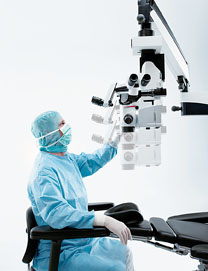Bausch + Lomb has added a new product to its signature lotepred-nol etabonate line: Lotemax Ointment.
Lotemax Ointment is indicated to treat postoperative inflammation and pain following ocular surgery. It is the first preservative-free topical ophthalmic steroid formulation in the United States and is the first monotherapy steroid ointment brought to the U.S. market in more than 20 years.
Two four-week clinical safety and efficacy evaluations of Lotemax Ointment showed statistically significant resolution of anterior chamber cells and flare vs. vehicle at postoperative day eight. Both clinical trials were Phase III, randomized, multicenter, double-masked parallel-group comparative evaluations to a vehicle (mineral oil and white petrolatum) for the treatment of inflammation and pain following cataract surgery (n=805 total) with Lotemax Ointment.
B + L is currently shipping Lotemax Ointment; the product is available only within the United States. For information, visit
bausch.com.
Heidelberg’s RegionFinder for Spectralis BluePeak Models
Heidelberg Engineering has released new software for the Spectralis product line. Version 5.4 adds the RegionFinder software to more than 2,500 installed confocal laser scanning ophthalmoscopes with the BluePeak Blue Laser Autofluorescence module. The RegionFinder allows the instrument to quantify and track dark areas on BluePeak images, typically used for following progression of geographic atrophy. The BluePeak technology helps clinicians to assess the health of the retina and helps to identify dry and wet age-related macular degeneration. Tracking geographic atrophy in dry AMD may be beneficial for determining the use of a host of emerging therapeutics. At least 16 new therapies are under development to help slow or stop progression to wet AMD.
Heidelberg Engineering customers will receive the software upgrade at no charge. For information visit
HeidelbergEngineering.com.
Clearance for Optovue’s RTVue Spectral-Domain Tomographer
Optovue’s RTVue spectral-domain optical coherence tomographer has received 510(k) clearance for OCT measurements of central corneal power, curvature and thickness in human corneas, pre- and post-cataract surgery. The RTVue can be used to calculate the Total Corneal Power of the cornea in eyes that have undergone corneal refractive surgery. Further, the RTVue directly measures posterior corneal power and does not rely on good preoperative vision or previous clinical record(s). The success of IOL selection in cataract surgery is largely determined by corneal power. However, corneal refractive power has previously been very difficult to measure in post-refractive patients.
The OCT System can image the posterior corneal surface with very high resolution, allowing it to measure corneal power precisely. “That is what is needed in post-LASIK eyes,” states David Huang, MD, PhD, who has been using the RTVue to measure corneal power in multiple clinical studies sponsored by the National Institutes of Health. The RTVue uses a proprietary corneal segmentation algorithm that has been at least as effective, if not more effective, than other currently existing methods for measuring corneal power. The corneal power, curvature, and thickness measurements by OCT are repeatable within a visit, as well as for pre- and postoperative visits. For information, visit
optovue.com.
 |
The new Leica M822 surgical microscope, with enhanced Red Reflex, combines Leica Microsystems’ optics with an innovative dual-illumination system that dramatically improves the surgeon’s view when performing cataract surgery, the company says. Ergonomic design for a comfortable working position during surgery and high-resolution video documentation also support ophthalmic surgeons in their quest for more precise and efficient operating techniques.
The Leica M822 has already been widely tested in the United States, Asia and Europe. Combining LED with halogen illumination, the new dual-illumination system produces a brilliant and stable Red Reflex. Efficiency is additionally enhanced by superlative optics and intuitive control, ensuring excellent results. High-resolution videos enable surgeons to discuss case studies and their procedures and thus improve surgical techniques. For information, visit
leica-microsystems.com.
Iridex Launches New MicroPulse Module
Iridex Corp. has expanded its product offerings by introducing an optional MicroPulse module in the company’s IQ532 (green) laser system, and now provides a complete portfolio of infrared, yellow and green laser systems which can deliver MicroPulse laser treatments.
MicroPulse is a patented laser technology pioneered by IRIDEX, which enables tissue-sparing photocoagulation therapies to treat eye diseases. An increasing body of evidence shows that MicroPulse laser treatments can induce a therapeutic response with no detectable tissue damage and with improved visual function when compared to conventional photocoagulation treatments.
MicroPulse is a tissue-sparing laser delivery therapy that works by electronically “chopping” the laser emission into trains of microsecond pulses. This enhances the physician’s ability to more precisely control the laser effects on target tissues, offering the potential for ocular treatment with fewer collateral effects than conventional laser treatments. For information visit
iridex.com.



